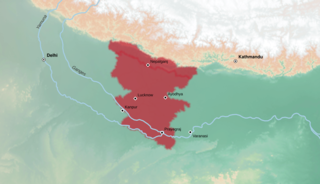
This article is about the demography of the population of Trinidad and Tobago including population density, ethnicity, education level, health of the populace, economic status, religious affiliations and other aspects of the population.

This is a demography of Guyana including population density, ethnicity, education level, health of the populace, economic status, religious affiliations and other aspects of the population.
Guyanese culture reflects the influence of African, Indian, Amerindian, British, Portuguese, Chinese, Creole, and Dutch cultures. Guyana is part of the mainland Caribbean region. Guyanese culture shares a continuum with the cultures of islands in the West Indies.

Bhojpuri is an Indo-Aryan language native to the Bhojpur-Purvanchal region of India and the Terai region of Nepal. It is chiefly spoken in eastern Uttar Pradesh, western Bihar and northwestern Jharkhand. It is an eastern Indo Aryan language and as of 2000 is spoken by about 5% of India's population. Bhojpuri is a descendant of Magadhi Prakrit and is closely related to Maithili, Magahi, Bangla, Odia, Assamese, etc. languages.
The music of Guyana encompasses a range of musical styles and genres that draw from various influences including: Indian, Latino-Hispanic, European, African, Chinese, and Amerindian music. Popular Guyanese performers include: Terry Gajraj, Eddy Grant, Dave Martins & the Tradewinds, Aubrey Cummings, Colle´ Kharis and Nicky Porter. Eddie Hooper The Guyana Music Festival has proven to be influential on the Guyana music scene.

Awadhi, also known as Audhi (औधी), is an Indo-Aryan language spoken in the Awadh region of Uttar Pradesh in northern India. The name Awadh is connected to Ayodhya, the ancient city, which is regarded as the homeland of the Hindu god Rama. It was, along with Braj, used widely as a literary vehicle before being displaced by Hindi in the 19th century.

The Guianas, sometimes called by the Spanish loan-word Guayanas, is a region in north-eastern South America which includes the following three territories:
Guyanese English Creole is an English-based creole language spoken by the Guyanese people. Linguistically, it is similar to other English dialects of the Caribbean region, based on 19th-century English and has loan words from West African, Indian-South Asian, Arawakan, and older Dutch languages.
Guyanese literature covers works including novels, poetry, plays and others written by people born or strongly-affiliated with Guyana. Formerly British Guiana, British language and style has an enduring impact on the writings from Guyana, which are done in English language and utilizing Guyanese Creole. Emigration has contributed to a large body of work relating the Guyanese diaspora experience.
Berbice Creole Dutch is a now extinct Dutch creole language, once spoken in Berbice, a region along the Berbice River in Guyana. It had a lexicon largely based on Dutch and Eastern Ijo varieties from southern Nigeria. In contrast to the widely known Negerhollands Dutch creole spoken in the Virgin Islands, Berbice Creole Dutch and its relative Skepi Creole Dutch were more or less unknown to the outside world until Ian Robertson first reported on the two languages in 1975. The Dutch linguist Silvia Kouwenberg subsequently investigated the creole language, publishing its grammar in 1994, and numerous other works examining its formation and uses.

The Wapishana or Wapichan are an indigenous group found in the Roraima area of northern Brazil and southern Guyana.

Pepperpot is an South Amerindian-derived dish popular in Guyana. It is traditionally served at Christmas and other special events. Along with chicken curry, and cook-up rice, pepperpot is one of Guyana's national dishes.

Caribbean Hindustani is an Indo-Aryan language spoken by Indo-Caribbeans and the Indo-Caribbean diaspora. It is a koiné language mainly based on the Bhojpuri and Awadhi dialects. These Hindustani dialects were the most spoken dialects by the Indians who came as immigrants to the Caribbean from India as indentured laborers. It is closely related to Fiji Hindi and the Bhojpuri-Hindustani spoken in Mauritius and South Africa.

In linguistics, a koiné language, koiné dialect, or simply koiné is a standard or common language or dialect that has arisen as a result of the contact, mixing, and often simplification of two or more mutually intelligible varieties of the same language.

French Guianese Creole is a French-based creole language spoken in French Guiana, and to a lesser degree, in Suriname and Guyana. It resembles Antillean Creole, but there are some lexical and grammatical differences between them. Antilleans can generally understand French Guianese Creole, though there may be some instances of confusion. The differences consist of more French and Brazilian Portuguese influences. There are also words of Amerindian and African origin. There are French Guianese communities in Suriname and Guyana who continue to speak the language.

Guyana, officially the Co-operative Republic of Guyana, is a country on the northern mainland of South America. Guyana is an indigenous word which means "Land of Many Waters". The capital city is Georgetown. Guyana is bordered by the Atlantic Ocean to the north, Brazil to the south and southwest, Venezuela to the west, and Suriname to the east. With a land area of 215,000 km2 (83,000 sq mi), Guyana is the third-smallest sovereign state by area in mainland South America after Uruguay and Suriname, and is the second-least populous sovereign state in South America after Suriname; it is also one of the least densely populated countries on Earth. It has a wide variety of natural habitats and very high biodiversity.

The people of Guyana, or Guyanese, come from a wide array of backgrounds and cultures including aboriginal natives, also known as Amerindians, those of Indian and African origins, as well as a minority of Chinese and European descendant peoples. Demographics as of 2012 are Indian 39.8%, Afro-Guyanese 30.1%, mixed race 19.9%, Amerindian 10.5%, other 1.5%.

The languages of the Caribbean reflect the region's diverse history and culture. There are six official languages spoken in the Caribbean:
Nowadays, no one could still claim his pure race status. Ethnic, social and linguistic differences become each day more and more present and marked all over the world. Time, history and continuous population intermingling across boundaries led to create cosmopolitan beings, that is to say world citizens who, in spite of their singularity, manage to bring themselves together in order to create a unique and single nation. Among the nations most affected by this cross-fertilization is notably found Mauritius. The social and linguistic diversity of this country makes it unique and contribute to its wealth. It arouses curiosity, urges us to deepen our knowledge on the subject and is, to this extent, worth being studied.

Indigenous Guyanese, Native Guyanese or Amerindian Guyanese are Guyanese people who are of indigenous ancestry. They comprise approximately 9.16% of Guyana's population. Amerindians are credited with the invention of the canoe, as well as Cassava-based dishes and Guyanese pepperpot, the national dish of Guyana. Amerindian languages have also been incorporated in the lexicon of Guyanese Creole.















